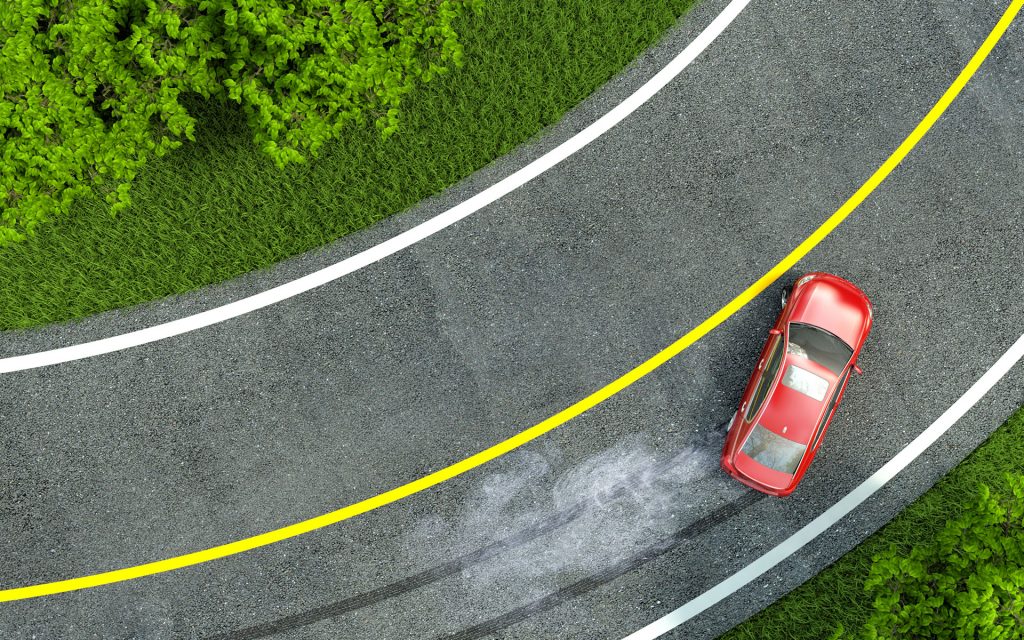Relationship Between Speed and Stopping Distances
For people learning to drive, one of the easiest aspects of the process to overlook is the distance that it takes to stop. Drivers can know how to stay in the lane, how to parallel park and perform many other tasks on the road but still have trouble with adjusting their speed for the conditions so that they can stop in time. Learning the relationship between speed and stopping distance, especially in different road conditions, is important for all drivers.
Every driver on the road is likely to experience different types of stops. When traffic is fairly sparse and the driver sees a red light or stop sign ahead, coasting slowly to a stop may be possible. However, the brakes are usually necessary for coming to a stop, whether at a red light or stop sign or to avoid an obstruction. For each situation, drivers should know the variables that can affect stopping distance, whether that includes a slippery road surface, failing brakes, or anything else that can cause a vehicle to take extra time to stop.
When road conditions or other factors make it difficult for drivers to stop on time, or when an emergency occurs such as a large animal suddenly jumping out in front of a vehicle, drivers may need to brake abruptly to avoid an accident. Sudden braking is always risky, as anyone travelling behind the vehicle must also do the same thing. However, it is sometimes necessary. If possible, drivers should always test out a vehicle’s brakes in a safe place to be sure that they will be abled to stop suddenly if necessary.
Thinking and Braking Distance
According to the Ontario Traffic Act website, stopping distance is the combination of thinking time and braking distance. At just under fifty kilometres per hour, a vehicle will travel approximately nine metres while the driver sees and responds to the need to stop and another fourteen metres after pressing the brake pedal. This distance is approximately the length of six cars. When drivers pay attention to the road and ensure that they maintain a sufficient distance between vehicles, they should normally have enough time to stop to avoid a collision.
The formula for thinking and braking works fairly well under normal conditions, but many factors can affect stopping distances. Brakes that are worn out or faulty will not work as well as they should, and the condition of the tires and road surface can affect how well the tires grip the road. Ice or snow, for example, can increase stopping distance significantly, while worn tires may not have the traction they need to grip the road’s surface properly.
The size of a vehicle can also make a significant difference. The weight of a large vehicle can propel it forward, making heavier vehicles harder to stop than smaller and lighter ones. As the Transport Canada website explains, large vehicles like heavy trucks or buses can take twice the time and distance to stop as cars do. That amount can increase with the momentum created by the weight of both the vehicle and its contents.
Kinetic Energy
All moving objects are affected by the force of kinetic energy, which Encyclopedia Britannica describes as a form of energy that an object has due to being in motion. A force working on the object, such as an accelerator pedal, increases the amount of kinetic energy according to how much force is applied. Even after a driver applies the brakes, kinetic forces continue to push the vehicle forward. This produces momentum, which be especially strong in large and heavy vehicles and can significantly increase their stopping distance.
Even for drivers of small vehicles, factors such as the weather can affect stopping distance. Summer rains can make the roads slippery, and wet leaves in the fall can cause vehicles to skid unexpectedly. However, winter is normally the time when Canadian drivers need to be the most careful about taking the necessary time for stopping their vehicles safely.
Winter and Studded Tires
In winter, stopping distances can be affected by many factors. As the Government of Ontario’s Winter Safe Driving document explains, all vehicles take longer to stop due to the road conditions. Wet, snowy or icy conditions can increase stopping distance, but the type of tire can also make a difference. Winter tires, for example, can decrease stopping distance by twenty-five percent in many cases.
In northern Ontario, vehicle owners also have the choice of using studded tires, which have small metal studs embedded in them to help grip the ice and snow on the road. Studded tires can improve traction in snowy conditions, but they still have limitations. Although these types of tires help to reduce stopping distances in many circumstances, they can actually increase stopping distances on bare pavement. Thus, drivers should be careful to change from studded tires to summer or all-season tires once the weather is warm enough to allow for reliably clear roads.

Besides factors such as the type and condition of the tires, one of the most important factors in stopping distance is speed. All drivers know that it takes longer to stop at faster speeds than at a slower pace, but they might not realize the exponential nature of stopping distances. Being able to judge approximately how long it will take a vehicle to brake could make the difference between being in a major crash or travelling safely along the road.
Speed and Skidding
According to the Physics Classroom website, the distance a vehicle will skid before coming to a stop is proportional to the square of the speed at which the vehicle is travelling. Thus, a vehicle travelling at about sixteen kilometres per hour will require just over a metre to stop abruptly once the driver has applied the brake. However, a vehicle travelling at just over thirty-two kilometres per hour would require almost five metres to stop. Rather than merely doubling when the speed doubles, this increased speed quadruples the amount of space necessary for stopping safely.
This factor becomes increasingly important as the speed of the vehicle increases. People who are accustomed to driving at relatively slow speeds in cities or towns should be especially careful to allow extra space for stopping on roads where the speed limit is higher, as it could take more than four times as long as they expect. If a vehicle or animal suddenly appears in front of a vehicle, the driver may not be able to stop in time to avoid a collision.
Increased stopping distance is closely related to the formula for thinking distance and braking distance. Various factors, including distractions and weather conditions, can increase the amount of space people need for stopping safely. Age can also be a factor, as the slower reactions that come with age mean that drivers tend to take longer to respond to situations they encounter on the road.
With so many factors influencing stopping distance on the road, drivers need to be especially aware of the factors that are under their control. They cannot change their age or physical state of health, and they cannot influence the weather. However, they can control their speed. When conditions call for slower speeds than normal, drivers should respond appropriately.
Choosing the Right Speed
In general, drivers are expected to keep up with traffic to avoid causing unnecessary delays, but they should also use their judgement to help keep the roads as safe as possible. Sometimes, this may mean avoiding high-speed roads entirely, especially with inexperienced drivers who may be unaccustomed to the techniques for operating vehicles on these types of roads. At other times, exercising good judgement may mean driving under the speed limit or staying far away from other vehicles where possible.
The decisions that governments make can also affect speed on the road. When the government of Ontario considered raising the speed limit on highways, as reported in a CBC article from May 6, 2019, a driving instructor named Michael Raymond expressed concern that increasing the legal speed would only encourage drivers to go even faster than before. That, in turn, would increase the distance necessary for stopping.

Like other instructors, Raymond teaches his students that doubling the speed of a vehicle means quadrupling stopping distance. Even increasing speed by ten or twenty percent can have a significant effect on how easy it is for vehicles to stop. If drivers begin to travel at 130 or 140 kilometres per hour on the highway, their stopping distance will increase substantially, possibly causing problems on the road.
Part of the issue is how well drivers understand the difference between highway and city driving. As the driving instructor notes, many inexperienced, and even experienced, drivers may fail to anticipate the extra space needed for stopping at highway speeds. Instead of increasing the distance between vehicles to allow for longer stopping distances at highway speeds, drivers often assume that they can follow closely behind other vehicles and still be able to stop quickly if necessary.
Learning how to stop a vehicle safely at different speeds is an essential part of safe driving. Unexpected situations can still arise, but drivers should give themselves the best possible opportunity to stop in a safe and controlled manner, and speed is the easiest aspect to change. Driving at an appropriate speed is the best way to make stopping safe for everyone.
